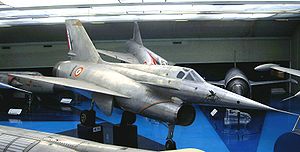North 1500
| North 1500 Griffon | |
|---|---|
 Griffon II in the Musée de l'air et de l'espace |
|
| Type: | Experimental airplane |
| Design country: | |
| Manufacturer: |
SFECMAS / Nord Aviations |
| First flight: |
20th September 1955 |
| Commissioning: |
Flight testing ended |
| Production time: |
Was never mass-produced |
| Number of pieces: |
2 |
The Nord 1500 Griffon was a French experimental aircraft with a mixed propulsion of jet and ramjet engine . The machine had its first flight in 1955. An improved version of the Griffon (Nord 1500-02 Griffon II ) set several records for speed and climb in the late 1950s. However , there was no further development into a combat or reconnaissance aircraft .
history
During the transition to jet-powered aircraft, which was already becoming apparent at the end of the Second World War , engineers were often confronted with the problem of underpowering combat aircraft. When the French Ministry of Aviation demanded a fast interceptor for the Armée de l'Air to defend against possible supersonic bombers in the early 1950s , Nord Aviation relied on the powerful ramjet engine , which however had the disadvantage of almost no thrust at low speeds to deliver. This disadvantage was to be avoided by giving the machine a mixed drive with a jet turbine for take-off and landing and a ramjet engine for cruising flight. The jet turbine was installed inside the north ramjet tube, which had a diameter of 1.37 m.
The first flight of the prototype took place on September 20, 1955 with the test pilot André Turcat . More than 150 flights followed by April 1957, after which the machine was scrapped.
North 1500-02 Griffon II
The second prototype differed from the first in the faired cockpit hood, an enlarged air inlet and the lack of small stabilizing fins at the stern. The second machine started on January 23, 1957. The drive system ran without problems, only the air inlet, which was still too small, restricted the performance.
End of the program
Mainly because of problems with the thrust control of the ramjet engine - the pilot practically only had the choice between full and no thrust - the project was abandoned. The Griffon II had made about 200 flights without solving the problems. The Mach-3-capable Super Griffon was no longer developed. At that time, jets without mixed propulsion had already won the competition.
construction
The Griffon consists essentially of a cylindrical fuselage that contains the two combined engines and a large part of the fuel. The cockpit is located above the air inlet. The machine has a delta wing swept by 60 ° and combined ailerons and elevators. Below the cockpit there were two delta-shaped trim surfaces that gave the aircraft duck-plane properties even at supersonic speeds.
use
After further modifications, the Griffon achieved almost unbelievable values with Mach 1.85 in the climb. In February 1957, the machine set several climbing performance records, for example it took a minute and 41 seconds to climb from a standstill to 9,000 m.
At the latest after André Turcat had completed a 100 km flight with an average speed of 1643 km / h in February and thus set a new world record, the Griffon II also became known outside of Europe. On October 5, 1960, the Griffon reached its absolute peak with 2.19 times the speed of sound.
Technical specifications
| Parameter | Data |
|---|---|
| crew | 1 |
| length | 14.54 m |
| span | 8.10 m |
| height | 5.0 m |
| Wing area | 32.0 m² |
| Empty mass | 6725 kg |
| Wing loading | 210 kg / m² |
| Top speed | 2330 km / h |
| Rate of climb | 100 m / s |
| Takeoff route | 600 m |
| Landing route | 1000 m |
| Engines | an axial air jet turbine SNECMA Atar 101E-3 with 34.3 kN (3500 kp)
and a ramjet engine Nord Stato-Réacteur with 68.0 kN (7000 kp) |
Received aircraft
The Nord 1500-02 Griffon II is on display in the Musée de l'air et de l'espace .
Comparable types
-
 United Kingdom : Avro 720
United Kingdom : Avro 720
-
 United Kingdom : Saunders-Roe SR.53
United Kingdom : Saunders-Roe SR.53
-
 United Kingdom : Saunders-Roe SR.177
United Kingdom : Saunders-Roe SR.177
-
 France : Sud Ouest SO9000
France : Sud Ouest SO9000
-
 France : Leduc 010/021/022
France : Leduc 010/021/022
-
 United States : XF-91 Thunderceptor
United States : XF-91 Thunderceptor
See also
Web links
- Nord Aviation Nord 1500 "Griffon". In: History of powered flight. EADS Deutschland GmbH, May 5, 2009, accessed October 17, 2009 .
- ONERA video about the wind tunnel development of the Nord 1500 Griffon 1958, in French